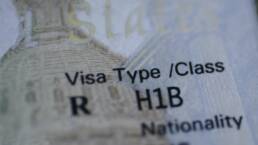On May 19, 2021, the Department of Homeland Security (DHS) issued a final rule which removes constraints put on H-1B applications from the 2020 interim final rule “Strengthening H-1B Non-Immigrant Visa Classification Program.”
What is an H-1B Non-Immigrant Visa?
The H-1B is a visa available to individuals who wish to work in a specialized occupation that requires at least a bachelor’s degree as a requisite qualification. To qualify for this visa, an applicant must:
- work in a theoretical and practical application of a body of highly specialized knowledge;
- have a bachelor’s degree or higher in the field of specialized knowledge (or an equivalent); and
- be engaged in specialty occupation.
H-1Bs Prior to the Final Rule
In October 2020, the DHS promulgated a rule which changed several definitions in the Code of Federal Regulations to narrow their scope on H-1B applications. These changes came from the Department’s claim that H-1Bs were no longer serving their original purpose. According to the DHS, rather than filling a shortage of skilled employees for US companies, these visas were choking out American citizens in the job market. Under this rationale, the definitions for words such as “employer-employee relationship,” “Specialty Occupation,” “worksite,” and “employer-employee relationship” were all altered to set a higher threshold for H-1B approvals.
The change in the definition of “specialty occupation” significantly heightened the burden for applicants under the new rule, which carried repercussions through the rest of the application. Under the old standard, an applicant needed to show that they were employed in a “theoretical or practical field of knowledge,” and that it required at least a bachelor’s degree. Under the interim rule, they would need to show a “direct connection” between the work that they were performing and the degree that they had obtained. This was the most dramatic change resulting from the new rule, but the narrow construction also applied to how employers could convey their relationship with the employee, where the employee would be working, and whether they were really an employee or a contractor. The interim rule significantly increased the burden of H-1B applicants to show that they qualify.
The Final Rule Changes
The DHS’s May 19 final rule merely codifies the law that has been in use since the Northern District of California vacated the interim rule in December 2020. When the DHS agreed to follow the court’s ruling, the interim final rule was no longer applicable to H-1Bs. However, the language from the interim rule was not removed from the Code of Federal Regulations at that time. Therefore, it was necessary at some point for the DHS to make changes in the language to reflect the law in practice.
The result of the final rule is to maintain the same standards for an H-1B application back to what they were prior to the interim rule. Applicants are no longer required to show a direct connection between their work and their degree they have. Also, employers and their beneficiaries have some flexibility on their applications with respect to the location of the work, the relationship of the parties, and their status as an employee or a contractor. These reversions should make it easier for applicants to qualify for H-1B visas, as well as having the code reflect the practiced law.
Ready to have Berardi on your side?
Whether you’re a business looking to hire or a professional hoping to relocate, immigration law can be complicated. But you don’t have to do it alone. Put our experience to work for you.



